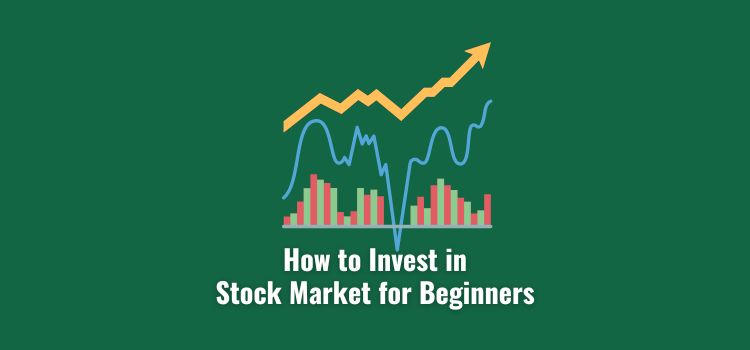Investing is the best way to get a very high return on your money. Hope you know there are no good returns in FD and Gold. In stocks, you can expect a good return with the right guidance. In this post, we will guide you on how to invest in the stock market for beginners.

While investing in the stock market beginners do a lot of mistakes because of a lack of knowledge and the right guidance. Making money through the stock market is very easy and simple if you learn some technical analysis, money management, and psychology in the stock market.
You are a beginner and I assume you don’t have much information about these things. That’s why I’ll share some steps you should follow while investing in stocks even when you don’t have knowledge about investing and fundamentals. Learn How to Start Trading in India (Scratch to Advance).
Related Posts:
- Top 5G Stocks in India to Invest in 2024
- Best Infrastructure Stocks in India 2024
- Best Electric Vehicle (EV) Stocks In India for 2024 and 2025
What is Investment in Stocks?
Investing in stocks means buying the ownership of any company using fundament and technical analysis in the hope that the company will grow in the future as a result your investment amount will grow.
Long-term investment gives a very high return as compared to FD, mutual funds (in some cases), investment in properties, etc. It is highly recommended that everyone should invest in the stock, there are a lot of benefits of investing in good or quality stocks.
-
High Returns: There are several stocks that gave 3x – 4x times the return on investment in the last 1-year ex. Adani Power, Adani Willmar, Tata Power, etc. To get a high return on investment you have to invest in quality stocks only.
-
Dividend Income: Companies pay a dividend on their profit to shareholders, some companies pay dividends each financial year, and some quarterly. The dividend amount per share depends on the company’s profit.
-
Ownership: By shares in any company means you are buying some stake in that company. A shareholder has the power to vote on the company’s decisions.
Requirements for Investing
You need several things to invest in stocks to get a high return on the investment. Most people avoid or don’t follow these things, and as a result, they do not get high returns.
-
Money: Of course, you need money to invest in the stock market, there is no minimum or maximum requirement. In short, more money means more return.
-
Quality Stocks: You should only invest in quality stocks if you are a beginner and don’t want to take the risk of money. There are a lot of stocks of very less price, but fundamentally they are dead.
-
Knowledge: You should have some fundamental and technical analysis knowledge, it will help you to take entry and exit at the right time.
-
Patience: This is the main problem of a lot of people, they need quick profit and they check their holding stocks each day. Sometimes due to bad news, the stocks go down and they exit due to a lack of knowledge and patience. Remember only one thing that you are investing for 5 – 10 years so, avoid the stocks up and down.
Long Term vs Short Term Investment
There are two types of investments i.e. long-term investment and short-term investment. In long-term investment, if you invest in stocks for more than one year then it is considered a long-term investment. On the other hand, if you invest from 2 days to less than 1 year then it will be knowns as a short-term investment. There will be no option to invest in the long term and short term, you will see only the delivery options.
-
In the long term, you’ll invest for a few years to get a high return. In the long term, you don’t need a high level of knowledge of price action or technical analysis. In long-term investment, you see a stock’s fundament.
-
In the short term, you’ll invest to get profit and in this, you must have knowledge of technical analysis. You take entry and exit on the basis of price action. The people who do jobs prefer short-term investment.
How to Invest in Stock Market for Beginners?
Below we will share some steps that will teach you how to invest in the stock market beginners. Here we will not talk much about fundament and technical analysis because you have to spend some time learning these things.
In investing, we will guide you on which sector you should choose, in which stock you should invest, how much money you should invest at a time, and much more.
Pro Tip: Very popular investors said that you should only invest in that sector’s stock you understand very properly.
Step 1: Open a Demat & Trading Account
You need a Demat and trading account for investing and trading. There are a lot of discount brokers available in that market like Kite, Upstox, etc. You can open your Demat account online from home in just a few minutes.
 Rating: 9.8/10 |  Rating: 9.1/10 |
Rating: 8.5/10 |  Rating: 8.6/10 |
A few brokers charge account opening charges and account maintenance charges as well. I recommend opening a Demat account with Upstox or Kite(Zerodha) because they are very popular for their services. Basic comparisons between them are below.
Kite (Zerodha)

Kite is a very popular broker among all the broker apps. This broker UI is very simple and easy to understand. Kite has all the features you need in a broker app. Below are the brokerage plans of Kite.
Kite annual AMC (account maintenance charge) for individuals is Rs. 300 + 18% GST. Kite also charges rs. 200 – 300 for account opening charge.
- Equity Delivery: Zero Charge
- Intraday: Rs. 20 per executed order (equity, F&O, currency, commodities)
- Mutual Funds: Zero Charge
Upstox

Upstox is also a very popular broker in the market. The UI of the app is very awesome and I think it is better than the Kite. This broker also has some unique features to trade in F&O. You can also check the broker mobile app without creating a Demat account. Below are the brokerages of the broker.
Upstox sometimes charges an Account opening charge and sometimes does not, Upstox does not take account maintenance charges. Visit the Upstox website for the latest update on it.
- Equity Delivery: Rs. 20
- Intraday: Rs. 20 per executed order (equity, F&O, currency, commodities)
- Mutual Funds: Zero Charge
Step 2: Where to Invest
In the stock market, there are a lot of options available to invest in. Not everyone knows about all the options for investing.
- Equity Shares
- Bonds
- Mutual Funds
- Exchange and Traded Funds
- Derivatives
Note: In this article, we will only discuss how to invest in the stock market for beginners (equity shares). Most of the people who have fundamental and technical knowledge, invest in themselves
Step 3: Choose the Right Sector
It is recommended by almost every pro-level investor that you should invest in only that sector’s stocks that you understand it. If you invest in the sectors you understand, then it will be easy to explore which stocks are doing good in that sector and which stocks can give high returns in upcoming years.
It does not mean that you should only invest in the sectors you understand. You can also invest in that sectors that are going to give good returns in the future ex. EV, green energy, etc.
Step 4: Stock Categories
There are three types of stock categories i.e. large-cap stocks, mid-cap stocks, and small-cap stocks. Here CAP stands for company.
Large-cap Stocks: Top 100 stocks by market cap are large-cap stocks, and large-cap stocks are defined by SEBI. Investing in large-cap stocks means a very low risk to your money in the long term.
Mid-cap Stocks: The stocks ranked 101 – 250 are considered mid-cap stocks by market cap. Again, mid-cap stocks are also defined by the SEBI. in these stocks the risk is moderate. So, if you are investing in mid-cap stocks then also check their fundamentals too.
Small-cap Stocks: All the rest stocks ranking after 251 are small-cap stocks. In small-cap stocks, there is a very high risk and return too.
Step 5: Choose Quality Stocks
After selecting sectors, locate the top and quality stocks of the sectors. You must have the fundamental knowledge to know which stock is quality or good stock and can give a high return in the near future.
As you are a beginner then most probably you don’t have information or knowledge about stock fundamentals. So, note down all the stocks of the sector or simply search for the top stocks of the sector and note down all the stocks.
Check all the stocks one by one on YouTube or blogs to check if everything is right in the stock or not. Note down all the stocks that are fundamentally good and strong. Then compare all the stocks of the sector and find the top stocks of the sector.
Note: The price of any stock can not define whether the stock is good or not.
Step 6: Avoid Panny Stocks
Most beginners buy stocks whose price is very less and thin and the stock will give a very high return in the future. If you are investing in penny stocks then most probably you’ll lose your money.
If you are a beginner and don’t have much knowledge about the fundaments and technical analysis then avoid penny stock to keep your money safe.
Step 7: Technical Analysis
Some beginner investors buy stocks at the current price without checking what could be the price of the stocks in the upcoming days. Buying stocks for investment could be a very great idea and you will make some extra return on it.
If you can’t wait for the level you draw using price action or technical analysis then there is a great feature available for you that is GTT (good till trigger). Using the GTT feature set the number of stocks you want to buy and the price. When the stock price will come at the price you set in the GTT, the stock will be bought.
In the GTT feature, the order validity is for 1 year. So, you don’t need to check the price all the time. In short, this is a very useful and amazing feature for every investor.
Step 8: Money Management
Money management is very important in investing as well as trading too. Beginners buy some stocks in huge quantities and some in very low quantities. I recommend you do not invest a lot of money quantity in a single or few stocks.
Do not invest all the money at once, suppose you have rs. 100,000 then divide the money into 4-5 parts and invest 1 part at one time. Sometimes the stocks may go down due to some reasons then it could be a good opportunity to invest.
When the quality stocks are available at huge discounts then buy more quantity to get a higher return in the future.
Step 9: SIP in Stocks
Then people who don’t have huge money but are saving some money from their salary then SIP is a very good option for them. Not only mutual funds, but you can also do SIP in stocks too.
So, pick some stocks and start SIP in the stocks. In SIP, there is a huge return because you are buying the stock in a month.
Step 10: No. of Stock in Portfolio
Just like money management, this section is also very important. Also, a lot of people also ask how much stock should i have in the portfolio. So, the question will be solved now.
If you are induced and can not give more time to the market then you should have 10 – 15 stocks in your portfolio. Do not have more than 2-3 stocks in any sector.
If you can track more than 15+ stocks regularly and have good knowledge of investment then you can keep them. Try to track all the stocks from time to time to save your money from big losses.
Step 11: When to Buy
You should always buy ant stock using technical analyses. If you buy stocks using technical analysis then most probably you’ll get a higher return in the future. One benefit of buying stocks is that you’ll get the stock at a low price, and as a result, you can buy more quantity.
Also at any technical level of any stock, do not invest all the money. If you save money then you can buy more quantity when the stock is down due to any reason.
Step 12: When to Sell
When you should sell your holdings? You should only sell your holdings when the below conditions meet:-
- When anything is wrong in the company.
- When anything is wrong with the stock’s fundamentals.
- You can sell when you need money and don’t have any option to get the money.
There can be also a lot of reasons to sell holding stocks. Do not sell any stock due to any small and big bad news because it may happen in some stocks.
FAQs
As a beginner, you need to remember several things before investing like where to invest, money management, which sector to choose, and much in order to get more return from investing.
While investing you should follow money management rules and try to invest in future growth sectors and stocks. Do not invest all the money at 1 time, invest money in some part and average it when the stock is at a low price in order to get a very high return.
Yes, you can invest rs 1000 in the share market.
There are a lot of good stocks you can buy like Infosys, HDFC Bank, IRCTC, and much more.
Final Words: We shared very basic to advanced information on how to invest in Stock Market for beginners. If you don’t know a single word about investing in the stock market then this post will help you a lot to learn a lot about the market. Read quality articles on business startups, business ideas, trading, the stock market, etc. on moviden.com.
